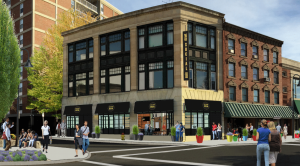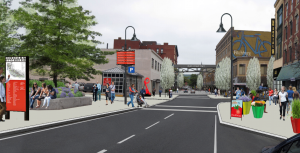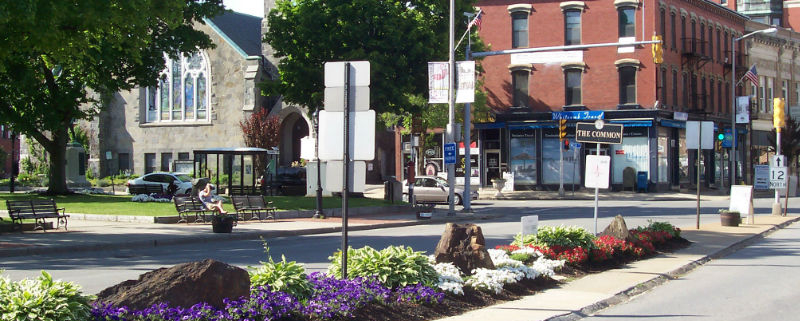Building North Central for the Next Generation
Imagine a modern renaissance, built on our past with the vision of a sustainable, modern future. Guess what? It’s happening right now in North Central Massachusetts. With more than 7,500 businesses based in the 27 communities that encompass North Central, we are building on the strong bones of our industrial past to redevelop buildings and create green living spaces, all while staying true to our traditional New England roots.
In 2020, a group of local business and community leaders, dignitaries and other key regional stakeholders got together to really understand what makes our region tick. The result is One North Central, a regional economic development plan to set a path forward for growth and opportunities.
One critical factor that bubbled to the surface early on was the North Central Massachusetts real estate market’s affordability compared to Greater Boston. Our region is home to more than 52 million square feet of industrial, retail and flex space, which is an increase of 375,000 square feet since 2006. And, with industrial and office lease rates approximately $15 per square foot, the region offers a relatively large share of competitively priced warehouse and distribution space. In fact, North Central Massachusetts offers the highest potential for industrial space demand, more than double when compared to the other four Massachusetts regions identified in One North Central. In fact, we have a unique competitive edge over many other regions closer to Boston—the lower cost of both owner and renter housing. It’s an advantage which could attract new talent to live in the region who could purchase homes typically out of reach in many other parts of the state.
The region’s plethora of unique historic downtowns and town centers with a variety of community types offer a wide spectrum of opportunities for businesses and families alike. Want to take a commuter rail to a walkable downtown or open a small business in an old mill? You can. Interested in building furniture in a state-of-the-art manufacturing facility, learning to design a video game in a tech lab or visit a farm or orchard for fresh produce? You can do that, too. For our region’s largest communities, downtown areas are fast becoming destinations for arts and culture, restaurants and green space that attracts residents, employees, and visitors to live, work, learn and enjoy.
“A major focus of our economic development is our Urban Renewal Plan focusing on the Mill Street and Downtown areas which are designed to create opportunity for private investment, stimulate economic growth, and improve and expand housing opportunities,” said Trevor Beauregard, Director, Community Development and Planning, City of Gardner, and Executive Director, Gardner Redevelopment Authority. “In concert with state funding and grants, the availability of lending for private development in Gardner is also stimulating the city’s targeted areas for development and growth.”
Beauregard highlighted the Timpany Crossroads Project as a well-sighted, successful private investment located along the commercial corridor at the corner of Route 2A and Route 68, which offers businesses convenient access to major roadways and provides maximum high visibility. And in March 2021, Community HealthLink announced it purchased 13 acres of land next to Walmart on Timpany Boulevard to build a new 20,000-square-foot facility. The new building will be fully ADA-compliant and LEED certified, and offer primary and family medical, dental and behavioral health services, as well as urgent care.
“We have a two-pronged approach to economic development in Fitchburg,” said Tom Skwierawski, Executive Director of Planning and Community Development, City of Fitchburg. “We are
looking at the west and east sections of the city in very different ways. On the east, we have agricultural, greenfield development sites with the potential for tremendous commercial development. On the west side, we have a commercial recreation hub that started with Great Wolf Lodge and is now home to Game On, both of which provide family experiences for recreation.”
A big challenge for Skwierawski is the current real estate market’s low inventory which is making it difficult to welcome new residents to the city. “While we want to create continuous activities for the weekend traveler, we also want to attract people who’ve been priced out of the greater Boston area. We want them to purchase a home and raise a family here, but that’s hard to accomplish when there is little to no real estate inventory available.”
The City of Fitchburg is also turning to its downtown area, which the city refers to as “InTown,” into a destination arts and culture hub surrounded by residential units for those priced out of Boston, Worcester and the Merrimack Valley. “We have the Moran Square project which includes 44 residential units and commercial development opportunities, and several projects along Main Street designed to increase traffic to the downtown area,” he said. “We’re currently working on the redevelopment of 655 Main Street which will create four rental units and become the future home of the Dario’s on Main restaurant; 805 Main Street which will provide eight units; and the former Harper Furniture building renovation which will connect with the former Summer Street Firehouse providing 44 units and commercial space.”
In addition to the city’s InTown redevelopment, Fitchburg State University was awarded a $475,000 grant from MassDevelopment in December 2021 for the Main Street Theater Block rehabilitation project, which will provide 500 to 2,200 square feet of additional space to accommodate restaurants, retail space, art galleries and studios. And, in keeping with the city’s mission of creating an arts and culture hub, the Fitchburg Art Museum and NewVue Communities are working together to create the Fitchburg Arts Community, which will bring approximately 60 units of affordable rental artist residences and workspaces to three historical buildings adjacent to the Fitchburg Art Museum.
While downtown is a key area for growth, Skwierawski said industrial development like the Amazon warehouse on Intervale Road is equally important. The 97,000 square foot warehouse, slated to open in August 2022, will provide up to 300 jobs in the region. “We are really excited about this development and are looking to expand an industrial park at the sand pit adjacent to the warehouse.”
 Just as Gardner and Fitchburg are looking to enhance their downtown areas, the City of Leominster is busting at the seams with business growth in its downtown area, said Amanda Curtis, Economic Development Coordinator, City of Leominster. “We are making significant investments in the downtown area, from our Monoosnock Brook Gateway Project to our upcoming Façade Program for downtown buildings. We want to make our downtown accessible for walking and outdoor dining,” she said.
Just as Gardner and Fitchburg are looking to enhance their downtown areas, the City of Leominster is busting at the seams with business growth in its downtown area, said Amanda Curtis, Economic Development Coordinator, City of Leominster. “We are making significant investments in the downtown area, from our Monoosnock Brook Gateway Project to our upcoming Façade Program for downtown buildings. We want to make our downtown accessible for walking and outdoor dining,” she said.
Planning for the Monoosnock Brook Stabilization Project began 2019 and is funded by two Municipal Vulnerability Preparedness (MVP) Action Grants totaling over $367,000. It’s an important project that will replace the current stone walls along the brook and the large culvert below the municipal parking lot off Mechanic Street. “The brook is a centerpiece of our downtown and provides a quiet respite for our residents and businesspeople during their lunch hour and lets families experience nature just a few steps from a bustling downtown area,” added Curtis. The project is expected to be completed in summer 2023.
Part of Gardner’s Urban Renewal Plan includes a pedestrian corridor with street markings and signage to make the public walkways more pedestrian and bicycle friendly. “We are working to expand the bike path from the [Mount Wachusett Community] college to downtown through a bicycle and walking network using shared streets and multiuse paths,” said Beauregard.
Speaking of bicycle friendly paths, the Twin Cities Rail Trail, which follows an abandoned rail corridor from downtown Fitchburg to Mechanic Street in downtown Leominster, is scheduled to be open to the public in 2023. The trail runs parallel to Route 12 and will be open for all non-motorized use. “By bringing the rail trail directly to Mechanic Street, cyclists and walkers will be able to access all of what downtown Leominster has to offer while being active outdoors,” added Curtis.
Just a few miles away is Devens, home to more than 100 businesses and organizations providing more than 4,000 jobs all bolstered by approximately 2,100 acres of open space and recreation land. Formerly known as Fort Devens, the former U.S. Army base is now home to bustling businesses in technology and innovation, as well as New England Studios, producer of such television shows and movies as Dexter, Defending Jacob and Castle Rock. Growth and development abound in this community, with King Street Properties developing a 45-acre biomanufacturing campus consisting of five buildings with 700,000 total square footage. And last summer, SMC Ltd., a medical device contract manufacturer, announced plans to double its footprint with the addition of a 207,000 square foot manufacturing and warehouse facility, resulting in approximately 400 new jobs.
For all its successes, sometimes growth can present challenges, as Leominster’s downtown growing pains can attest to. With just about every square foot of downtown commercial space filled, the Economic Development Office is working in collaboration with Mayor Dean Mazzarella and downtown business owners to both find additional space while maintaining that uniquely positive small town, customer experience. Curtis noted, “We have monthly downtown business group meetings with our business owners so we are made aware of their challenges and how we can work together to create solutions.”
Curtis was quick to point out the Mall at Whitney Field is a hot topic of conversation in Leominster, with many rumors swirling about the future of the mall and surrounding area. “The mall is a work in progress and while there are many rumors about the future of the mall, including tearing it down, this is simply not the case,” said Curtis. “The investors who own the mall want to see this succeed so in this case patience is asked by all in the community while we work to figure out the best path forward.”
Collaboration is certainly key, not only with business owners, but also between other cities and towns in the region. “What we’ve realized over the years is that we cannot achieve our goals as a city without partnering with other cities in the region,” said Curtis. “We want our businesses to thrive and if Leominster cannot accommodate the needs of a new business or a business that needs to grow its footprint, we will work with other communities to collaborate and help our business owners find the most appropriate location to achieve their goals.”
Skwierawski and Beauregard also praised their respective city officials for collaborating with them on several of the economic development projects, both past and current.
“We are all rowing in the same direction and by having our Mayor, City Council, NewVue Communities, ReImagine North of Main, the Fitchburg Redevelopment Authority, and the North Central Massachusetts Chamber in our corner, it makes our work a lot easier. But more importantly, a collaborative environment provides business owners with the confidence that we will work as a team to help them achieve their goals.” Beauregard also said the Gardner City Council and its Mayor Mike Nicholson are all very supportive of all the city’s initiatives, which makes it much easier to move projects forward seamlessly and as quickly as possible.
It’s truly an exciting time to see how our cities and towns are redeveloping areas by modernizing buildings from our past, creating sustainable housing and establishing recreation areas connecting cities together as we work toward building North Central Massachusetts for the next generation.



